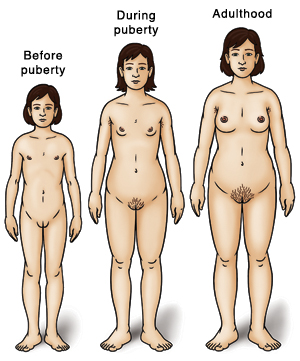Puberty: Normal Growth and Development in Girls
Puberty: Normal Growth and Development in Girls
Your child has reached the stage of adolescence called puberty. During this stage, your child’s body begins to develop and gain sexual maturity. This sheet tells you what to expect during this stage of your child’s growth and development.
How long does puberty last?
In girls, puberty usually begins between the ages of 9 and 14. Once it begins, it lasts about 2 to 5 years. But every child is different. And there is a wide range of what is “normal.” Your girl may begin puberty a little earlier or later and finish sooner or later than her friends. If you have questions or concerns about your child’s development, talk to your child’s healthcare provider.
Physical changes during puberty
Height and weight:
About 20% of adult height is gained during puberty. Girls begin to grow taller fairly early in puberty.
About 50% of normal adult weight is gained during puberty. The hips, thighs, breasts, and stomach often gain more weight than other areas. Also, a girl’s body fat percentage commonly doubles by the end of puberty.
Sexual development and hair growth:
At the start of puberty, breasts start to develop. Usually this begins around age 9 or 10, but can normally happen earlier or later. This is called “breast budding.” At this time, a hardening can be felt under the nipple. One breast often starts to grow before the other. Breast budding can cause the breasts to be tender or even painful. This is normal and not a sign of a problem.
Pubic hair begins to grow next (In about 10% of girls this happens before breast bud development). The hair comes in thinly at first, but eventually grows darker and coarser. Leg and underarm hair also begins to grow 1 to 2 years after start of pubic hair growth.
Girls usually begin menstruating (having periods) between the ages of 9 and 16. The average age is 12, but starting periods earlier or later is normal. Before actual periods begin, girls may have several months of clear or whitish discharge. This is normal. It is also normal for menstruation to be irregular during adolescence. However, a girl can still become pregnant even if her periods are not regular.
Acne and body odor:
Hormones that increase during puberty can cause acne on the face and body.
Hormones also increase sweating and cause a stronger body odor.
Reassuring your child
Your child may be concerned that her peers are more or less developed than she is. Explain to your child that kids of the same age may be at different stages of puberty. Your child’s growth, whether slow or fast, is happening at the right rate for her.
Help your child adjust to her changing body. Offer solutions for body odor and acne (such as bathing more often, using deodorant, and using acne products).
Your child will likely feel uncomfortable discussing sexual changes with you. Let her know you are there to talk to. You may also consider giving your child a book with information about puberty that she can read on her own.
Exams during puberty
As puberty begins, it’s important for your daughter to see her healthcare provider once a year. Continue bringing her in for regular health screenings, at least once a year. Know that, throughout puberty, health screenings will involve exam of your child without clothes. This lets the healthcare provider see how your daughter is progressing physically through puberty. Reassure your child that this exam is normal and expected. Also, parents may be asked to leave the room during a portion of the exam. This is so the child and the healthcare provider can have an honest and open discussion. If you have any questions or concerns, talk to your child’s healthcare provider.
Updated:
March 21, 2017
Sources:
Williams Textbook of Endocrinology. Melmed, S. ed. 13, p. 1130.
Reviewed By:
Adler, Liora C., MD,Bass, Pat F. III, MD, MPH
